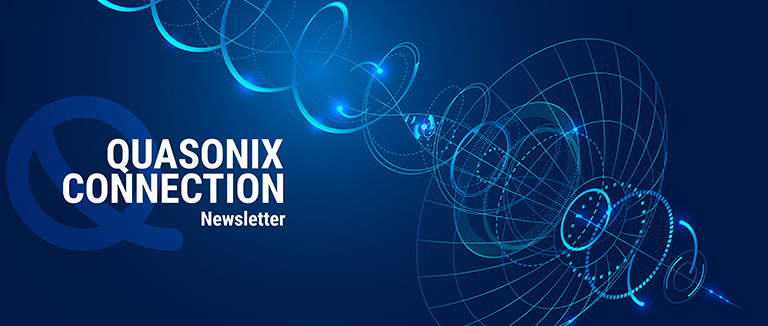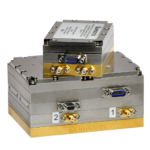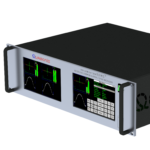
News from the company that's...
Reinventing Telemetry™
April, 2021
Would you like to improve your telemetry link? How about your post-mission analysis? Or maybe you’d like to reduce the time, cost, and frustration of troubleshooting the link in the first place? If any of those are true, then Data Quality is your new best friend.

The Data Quality Metric is a measure of received signal quality. More specifically, it is an estimate of bit error probability (BEP). Quasonix RDMS™ displays a streamlined version of DQM known simply as “Q,” which ranges from zero to ten. A zero means there is no confidence that the bits have been received correctly; a ten indicates that the probability of bit errors is less than one in ten billion – essentially perfect data.
What’s “magical” about DQM is that it works all the time – with any data, even encrypted, and any data modulation. This is because determining the error probability of any given bit is done without knowing what the bit is supposed to be. DQM is calibrated and verified against a wide variety of signal impairments, making it not only highly accurate but also interoperable among equipment vendors.
Because it reliably indicates the real-time likelihood of an error for every bit received, DQM enables several key benefits:
- It is at the heart of the Best Channel Selector (BCS) built into our RDMS™.
- End-to-end mission performance can be evaluated using a recording of DQM from the Status Logger with no knowledge of the received data.
- DQM is a great diagnostic tool. For example, if you know the signal is clean (Q = 10) but your decomm still won’t sync, it’s very likely that your baseband encoding at the transmit end doesn’t match the decoding at the receiving end (randomizer, differential encoding, etc.).
To learn more about Data Quality and how it fits into troubleshooting your link setup, read our new guide, DQM and RDMS™ Troubleshooting.

A Better Two-Antenna Solution
Are you experiencing unexpected signal fades and data dropouts during testing? Your problem may be antenna self-interference. If so, Space-Time Coding (STC) can save the day.
Many aircraft use a single transmitter and split the output between a top and bottom antenna. Although this technique provides full RF spatial coverage, the two signals can constructively or destructively combine. This can result in deep signal fades of 20 dB or more.
STC was developed to transmit the same data in non-interfering streams. The signals are encoded so that they are orthogonal over the duration of a code block, meaning that the average net effect that they have on each other is zero. Both streams carry every data bit, so when only one transmit antenna is visible from the ground, no data is lost. Importantly, this coding wizardry happens with both streams at the same frequency, eliminating the need for two RF channel assignments, and it does so with almost no loss in power or bandwidth efficiency.
Implementing STC requires replacing the single-output transmitter and power splitter with an STC-capable model (with two RF outputs) and replacing the traditional receiver with one that is STC-capable. Benefits include simplified RF plumbing – which can easily save several dB of transmit losses that directly impact the communication link performance – and streamlined troubleshooting.
Is it worth it? Ask our customers. There are now more than 250 STC transmitters and over 1,000 STC-capable receivers in the field. They are used in every branch of the Department of Defense and by numerous commercial customers. And those who have started using STC equipment are coming back for more: So far, nearly 75% of first-time buyers of STC transmitters have made repeat purchases.
For additional details on STC, read our article in Aerospace Testing International or contact us at sales@quasonix.com.
SAVE on our Latest RDMS™ Features

Here are just a few reasons to upgrade to Gen 3:
- Field upgradable via SD card or network connection, so you can easily take advantage of ongoing updates and innovations.
- An improved Adaptive Equalizer, which uses decision-directed feedback to tackle harsh channels and provide cleaner results. The industry’s best weapon against multipath fading.
- Support for the HyperTrack™ digital ACU interface as well as the legacy AM/AGC ACU interface.
- Improved graphics, including much smoother constellation and eye pattern presentation, and a three-channel spectrum analyzer.
- Test Utilities. Use the built-in Noise Generator and Data Generator for system testing and to verify transmitter or receiver RF integrity.
- Extended Frequency Tuning, which allows for contiguous tuning from 200 MHz to 2500 MHz and from 4400 MHz to 5250 MHz, supporting applications that operate outside the normal telemetry bands.
- A new Combiner IF Output, which facilitates recording of that signal on standard IF recorders.
- An Enhanced RDMS™ API, giving you greater control, feedback, and flexibility.
- Remote control available via standard web browsers.
- All six IRIG variants of Low-Density Parity Check (LDPC) decoding and improved sync time vs Gen 2’s single 4K block rate 2/3 code variant.
- Improved Space-Time Coding (STC). Gen 3 has both superior performance and UI status vs. Gen 2.
- Data Quality Metric (DQM) / Data Quality Encapsulation (DQE), and the Best Channel Selector (BCS), with all the benefits outlined in the lead article above, and more.
Contact us today at sales@quasonix.com to order yours!
